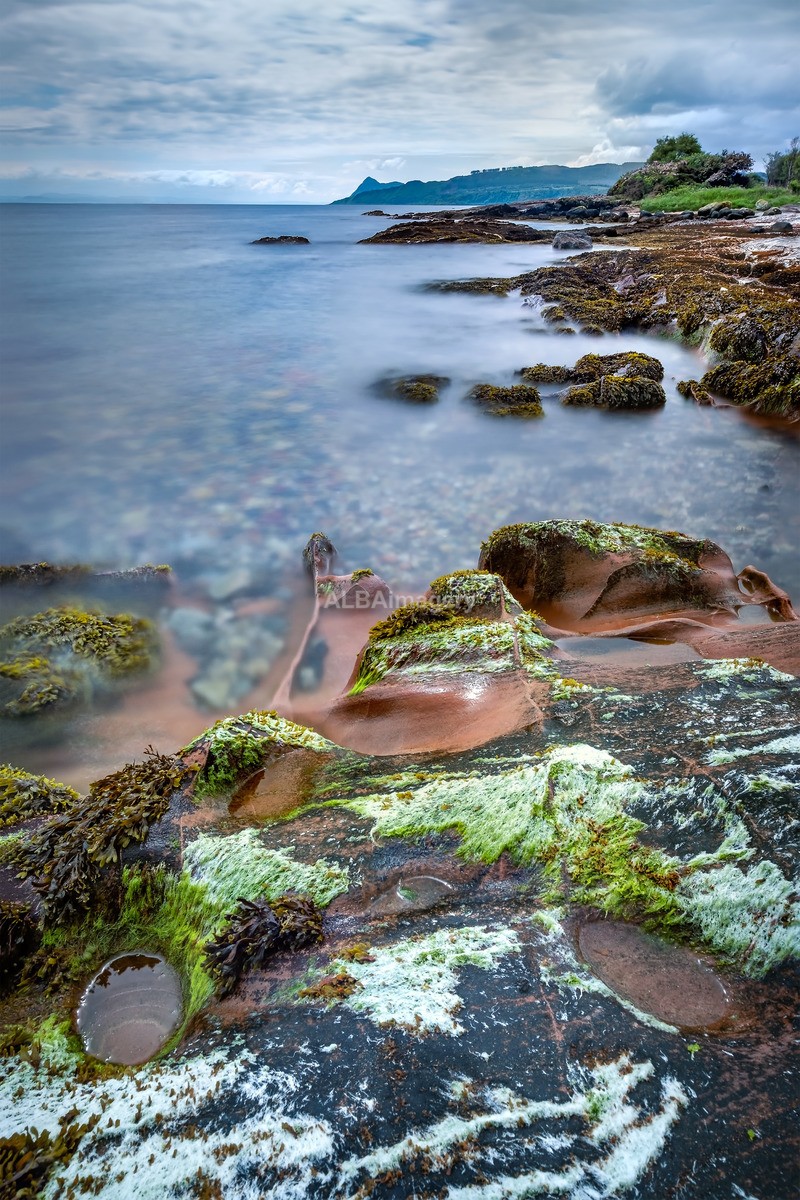Corrie Shore, Arran

Image taken : 2018-06-11 - 13:12, Fujifilm X-Pro2, XF 10-24mm f/4R OIS @ 15.10mm, 20sec, f/11, ISO200.
Corrie (Scottish Gaelic: An Coire) is a village on the north east coast of the Isle of Arran in Scotland, 6 miles (10 kilometres) north of Brodick. It lies 2 mi (3 km) due east under the island's highest mountain, Goat Fell. A path from High Corrie 3⁄4 mi (1.2 km) to the south, provides access to the hillside. Corrie, and its northern neighbour, Sannox, lie approximately halfway between Brodick and Lochranza.
The village used to be a regular stop for steamers circumnavigating the island, passengers embarking by way of a rowing boat from the "ferry rock". The ferry rock is located midway between the village's two quays. The southernmost quay is known as the "sandstone quay". This harbour and quay used to be the location where sandstone blocks from the nearby quarry were shipped to the mainland, and huge pieces of stone can still be seen. (Sandstone from Corrie was also used in the construction of Kirn & Sandbank Parish Church in Argyll and Bute.) The sheep bollards on the quay walls were moved to Corrie after they were used in the 1988 Glasgow Garden Festival. The northernmost quay is "Corrie port" and was also used for shipping products to other locations on the island, the mainland and other islands. Small coastal cargo vessels of a type known as the Clyde puffer were a common sight in the port and the sandstone quay during their heyday. There was also a limestone "mine" in the village, which has a roof lined with fossils of Gigantoproductus.
The note above is taken from the Wikipedia article "Corrie, Arran", which is released under the Creative Commons Attribution-Share-Alike License 3.0.
Check map position at Corrie (Opens in new window)
Corrie (Scottish Gaelic: An Coire) is a village on the north east coast of the Isle of Arran in Scotland, 6 miles (10 kilometres) north of Brodick. It lies 2 mi (3 km) due east under the island's highest mountain, Goat Fell. A path from High Corrie 3⁄4 mi (1.2 km) to the south, provides access to the hillside. Corrie, and its northern neighbour, Sannox, lie approximately halfway between Brodick and Lochranza.
The village used to be a regular stop for steamers circumnavigating the island, passengers embarking by way of a rowing boat from the "ferry rock". The ferry rock is located midway between the village's two quays. The southernmost quay is known as the "sandstone quay". This harbour and quay used to be the location where sandstone blocks from the nearby quarry were shipped to the mainland, and huge pieces of stone can still be seen. (Sandstone from Corrie was also used in the construction of Kirn & Sandbank Parish Church in Argyll and Bute.) The sheep bollards on the quay walls were moved to Corrie after they were used in the 1988 Glasgow Garden Festival. The northernmost quay is "Corrie port" and was also used for shipping products to other locations on the island, the mainland and other islands. Small coastal cargo vessels of a type known as the Clyde puffer were a common sight in the port and the sandstone quay during their heyday. There was also a limestone "mine" in the village, which has a roof lined with fossils of Gigantoproductus.
The note above is taken from the Wikipedia article "Corrie, Arran", which is released under the Creative Commons Attribution-Share-Alike License 3.0.
Check map position at Corrie (Opens in new window)